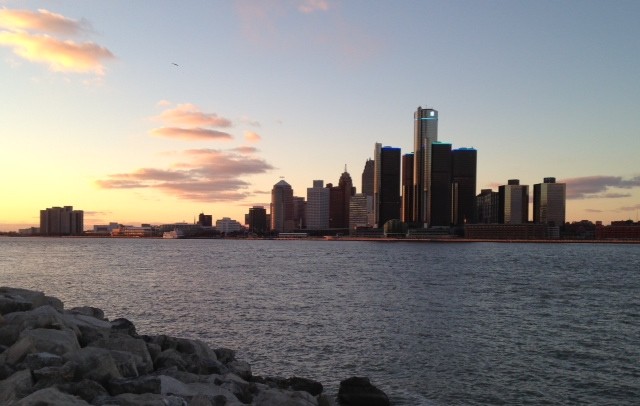Last week, U.S. Bankruptcy Judge Steven Rhodes approved a reorganization plan for Detroit, bringing the biggest municipal bankruptcy in U.S. history to a close.
Robert Snell led the team of reporters covering this once-in-a-lifetime story for The Detroit News. He also covers U.S. District Court and federal agencies in Detroit, including the Department of Justice, FBI and DEA. Snell already had bankruptcy experience under his belt. As the paper’s General Motors beat reporter, he also led coverage of the automaker’s historic collapse and bankruptcy.
The Detroit chapter of the Society of Professional Journalists named him the 2014 Journalist of the Year for his coverage of Detroit’s bankruptcy and the corruption trial of former Detroit Mayor Kwame Kilpatrick.
I talked to him via email about how he covered the Detroit bankruptcy, and the advice he has for other journalists in covering financial crises.
Stories like this come along once in a generation. How did the Detroit News organize its bankruptcy coverage? How big was the team?
The team was primarily four reporters: Capitol reporter Chad Livengood, David Shepardson from our Washington bureau, Christine Ferretti from our City Hall bureau and me. The team was supplemented by reporters from the Metro, Features and Business desks. We had daily meetings with our editor Kelley Root, who worked closely with our Breaking News Editor Kevin Hardy to edit and post bankruptcy stories at all hours of the day.
Who have been some of the personalities that stood out to you?
Judge Rhodes, definitely. He set the tone during the first hearing when heavy-duty bankruptcy lawyers from across the country showed up unprepared and promptly were pinned down by the judge’s questioning. He does not suffer fools.
Another personality was Stephen Hackney, a lawyer for bond insurer Syncora, arguably the city’s most outspoken creditor. Hackney and his colleagues argued controversial, aggressive positions, including sale of the Detroit Institute of Arts collection, and fought efforts to fix broken streetlights. The interplay between Hackney and Rhodes was fascinating to watch. It appeared that the judge respected Hackney’s zeal, until Syncora leveled personal accusations against mediators working on the case, which angered Rhodes.
One of the most notable aspects of the Detroit bankruptcy was The Grand Bargain. Explain that, and tell us why you think the movers and shakers were willing to come together to fund it.
The Grand Bargain is one of the main pillars of Detroit’s debt-cutting plan. It created a pool of money from the state, several regional and national foundations and the Detroit Institute of Arts to shield the art collection from creditors and soften retiree pension cuts. The deal eliminated potentially years-long fights over two of the most divisive issues in the bankruptcy: the fate of the art collection and cuts to retiree pensions. I think the idea attracted support because it was a rare opportunity to give Detroit a clean start and if the city could emerge from bankruptcy, real progress could be made tackling social problems that are the traditional focuses of the foundations.
There were several stand-out moments but perhaps the most vivid memory was the day Judge Rhodes invited dozens of retirees to testify about the impact pension and benefit cuts would have on their lives. It was raw, emotional and brought a human perspective to a case that on many days centered on bonds, complicated financial dealings and the fate of oil paintings and sculptures at the city’s art museum.
You made great use of social media during the case, especially your use of photos. (His Twitter handle is @RobertSnell_DN.) What inspired you to do that?
I maintained a blog during the corruption trial of Kwame Kilpatrick, the city’s former mayor.
The blog used tons of photos, videos and links to documents. I wanted to add those elements to our coverage on Twitter. There are huge limitations to covering a case in federal court: cameras are not allowed so the challenge is trying to help people picture what is going on inside the courtroom. That’s why I included photos of each lawyer, links to their bios and links to documents being shown in court.<
What is your advice for other journalists covering a Chapter 9 case?
I would find a Chapter 9 legal expert who can help explain the law. We brought in a local Chapter 9 expert who held a crash course seminar for our reporting and editing team before Detroit filed bankruptcy, and we tapped him for analysis throughout the case. I would also study some of the bigger cases nationally like Stockton, CA, and Jefferson County, AL. Before Detroit filed, I read all of the first-day filings in those other cases so I had a better idea of what to expect and we interviewed some of the major figures in those cases. Also, get a PACER account and familiarize yourself with the court filing system. You’ll use it a lot.
Any next plans? Will you be writing a book, doing a documentary, or taking time out for a fellowship?
No major plans right now. I love my job and Detroit is a great news town. I just want to keep reporting here as long as possible.












